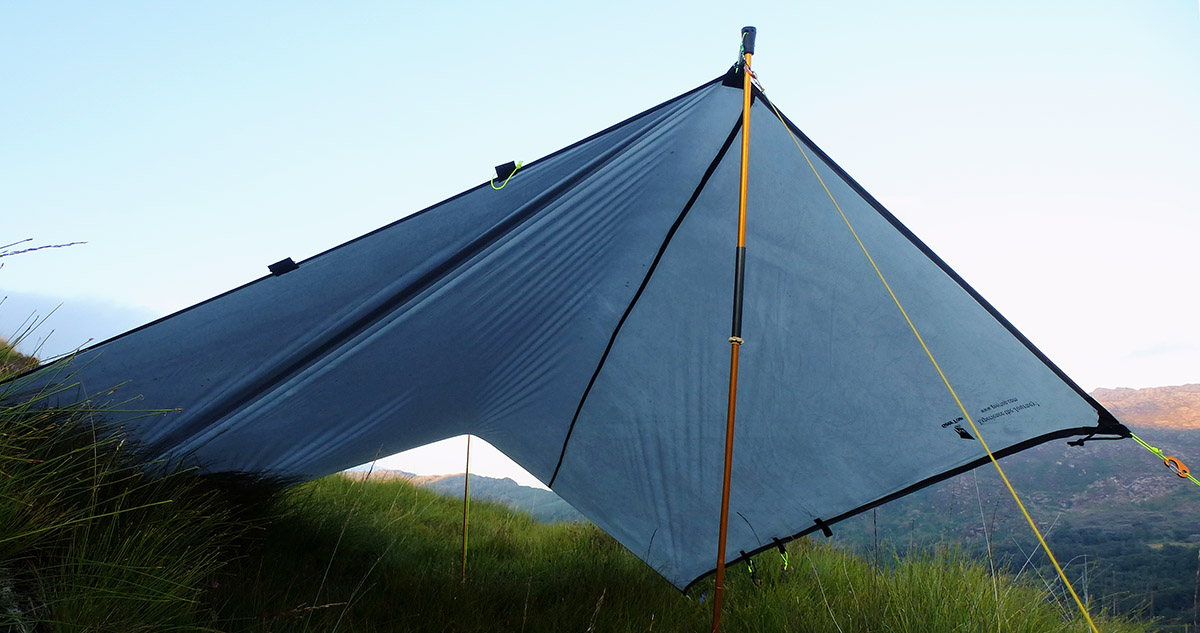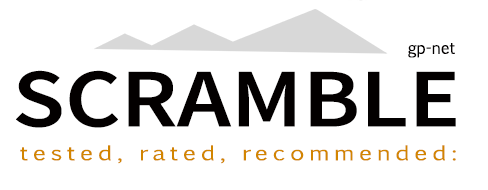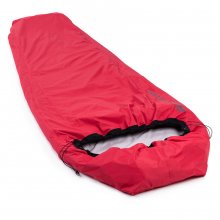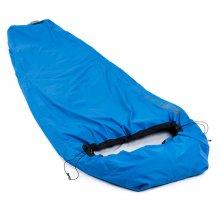Alpkit's Hunka Bivvy Bag
Preface
To understand how we arrived at the tarp + bivvy bag setup for long duration treks in warmer conditions, please read our companion post "Reasons To Go Modular".
As always, we're looking at the Alpkit Hunka from the point of view of long distance trekking over tough terrain.
Test subject: Chest 42", Waist 33", Height: 5ft 8"
Test item: Alpkit Hunka Kelp Version (= 30g heavier)
Kit Tests: Summer, Spring
Disclaimer: None required (item not provided by manufacturer)
Datasheet
| Materials: 2.5 Layer Ripstop Nylon | 100% |
| Waterproofing (Hydrostatic Head): | 10,000 mm |
| Breathability (Moisture Vapour Permeability - MVP): | 10,000 g/m²/24 hour |
| Weight (Stated / Measured - Kelp Version): other colourways are 30g lighter | 360g / 371g |
| Product Dimensions (Deployed = Length x Width @ Shoulders x Width @ Feet): | 215 x 80 x 50 cm |
| Product Dimensions (Packed): | 13 x 15 cm |
| Product Sizing Reference (Height): max 6'1" / > 6'2" = | Hunka / Hunka XL |
| Manufacturer RRP (Hunka) | £47.00 |
Scramble Review
Introduction: A Little Context
For cool to sub zero conditions, we recommened a modular tent comprising a hooped bivvy and an ultralight micro / porch tarp. However, in warmer conditions, where nighttime temperatures are 5°C+ we like to slim down the bivvy and beef up the tarp. In the latest Summer Kit Test (2018) I used a simple, minimalist bivvy bag, the Alpkit Hunka (under review here) with Scramble's G-Mod 55 Deluxe Solo Tarp:
 A great combo for long distance treks: Scramble's G-Mod 55 with Alpkit's Hunka Bivvy
A great combo for long distance treks: Scramble's G-Mod 55 with Alpkit's Hunka Bivvy
Ultralighters could make a reasonable case that, for summer, this tarp is a little over the top, but a) I was running our final beta test of the G-Mod 55, and b) it's a deluxe solo tarp (easily housing 2 bivvy bag users), and the extra space it provides for the solo trekker comes without too much of a weight penalty. The 12 days, 180 miles and over 30,000 feet of total elevation was noteworthy for its lack of "frustrating" moments.
In conjunction with the Hunka, I used another Alpkit product, the 450g Cloud Cover down quilt / bag (Scramble's recommended summer sleeping bag) pictured below:
 Alpkit's Hunka, the Nordisk Ven 2.5 sleeping mat and Alpkit's Cloud Cover down bag
Alpkit's Hunka, the Nordisk Ven 2.5 sleeping mat and Alpkit's Cloud Cover down bag
So What Cha Want?
What we're after from our bivvy is pretty straightforward - obviously, it has to be waterproof but we don't want to boil in the bag, so it also has to allow water vapour to escape. Aside from that, just a simple adjustable hood and a quick and easy method for packing it away and that should do. Afterall, we're after a pretty minimal, reasonably light yet tough bag that has as few breakable features as possible.
Let's see what the Hunka has to offer ...
1) Waterproof & Breathable
A bivvy bag is just a waterproof cover to keep your sleeping bag dry. All waterproof elements face a fine balancing act between keeping water out while preventing condensation forming on the inside. So a good bivvy will keep water droplets out while allowing moisture from our snug sleeper to escape through the bivvy's waterproof membrane.
Waterproof fabrics use a membrane sandwiched between a protective outer face (keeping water out) and a wicking inner layer (that transports condensation away from the body to the outside face of the fabric). The nature of the inner layer determines whether a fabric is 3, 2.5 or 2 layer.
- 3 Layer: the outer, membrane and inner are bonded together into a single flexible material
- 2.5 Layer: the outer and membrane are bonded together and given a very thin internal carbon or texturised so called "half layer"
- 2 Layer: the outer and membrane are bonded together, but the internal lining is a loose-hanging fabric or mesh
The Hunka uses 2.5 layer ripstop nylon which has a pretty large hydrostatic head of 10,000mm (which means a water column 10 meters high can sit on top of the fabric before it starts to seep in).
Having no zipped opening makes waterproofing that much easier and I had no problem getting in and out of the bivvy.
 Inside Alpkit's Hunka bivvy bag: 2.5 Layer Ripstop Nylon
Inside Alpkit's Hunka bivvy bag: 2.5 Layer Ripstop Nylon
If you want to take a deep, geeky dive into the world of the waterproof and the breathable, UKC has an excellent in depth article called: "Waterproof Breathable Fabric Explained". Here, I'll simply report my experience of using the Hunka bivvy.
Over the last Summer Kit Test, nighttime temps were generally between 8 and 15°C, and conditions varied from cloudy to clear; fresh to muggy. I felt the Hunka did a pretty good job keeping condensation to a minumum. Most mornings, the foot end of the Cloud Cover was a little damp, but not soaked. In summer this is not a problem and often the Cloud Cover would be bone dry by the time I needed to pack it away.
There is, however, no doubt that in cooler, wetter conditions, the temperature differential between the heat inside the bivvy and the cold outside, would cause significant condensation. When it's cold and wet, day in and day out, you can't easily dry your sleeping bag. This is one of the main reasons we don't use bivvy bags in cool or sub zero conditions; the accumulation of moisture can become a problem when trekking over multiple days and weeks.
2) Simple, Adjustable Hood
The Hunka has two adjusters, one to tighten the hood round the head and the other to close the bivvy at the neck.
If I was designing the hood and neck adjusters, I'd have split the function of the left and right toggles and colour-coded the banding across the neck opening (e.g. red) and the hood hem (e.g. blue). I'd have used a red toggle with red cord on the right side and a blue toggle with blue cord on the left (or vice versa). That way the user would know, to cinch in the hood, they would just pull the blue cord on one side and, conversely, to tighten at the neck, they'd pull the red cord on the opposite side.
As it is, you can cinch in the hood or the neck opening from both sides, each has two cords, but these two cords are often twisted and it's not easy to tell which is which. I spent more time than I should have, fiddling with these adjusters.
 Pictured right you can see the two cords responsible for cinching either hood or neck
Pictured right you can see the two cords responsible for cinching either hood or neck
The impression I have is that Alpkit have gone for what is easy to make, rather than what is easy to use (perhaps to keep costs down). But I'd pay an extra few quid to have the independent system outlined above.
We've docked 1.5 points for function.
3) Easily Packable
The Hunka has an integrated mesh stuff sack built into the foot-box. This works very well and I like this approach. It's very easy and quick to pack away. Nothing to moan about here.
 The integrated mesh stuff sack makes the Hunka quick and easy to pack and deploy.
The integrated mesh stuff sack makes the Hunka quick and easy to pack and deploy.
Bugbear
A major weakness of the tarp + bivvy bag setup is the lack of any meaningful barrier between the user and biting insects. We tested the Alpkit Hunka and the G-Mod 55 tarp with the excellent Sea To Summit Nano Solo Net.
 The Hunka worked well combined with Sea To Summit's mosquito net
The Hunka worked well combined with Sea To Summit's mosquito net
Over the 12 days, I slept extremely well in the Hunka. It's quite windproof and in conjunction with a good tarp, reduces some of the thermal burden on the sleeping bag, especially when combined with good sleepwear.
Hunka & Friends
Below is the complete sleep & shelter setup used on the 2018 Summer Kit Test. Alpkit's Hunka (D) makes for a pretty tidy package.
 Note: stated weights include stuff sacks where applicable
Note: stated weights include stuff sacks where applicable
Any Negatives?
The only real negative is the aforementioned neck and hood adjustment system. It's by no means a deal-breaker but it's certainly something Alpkit might look to improve. We've docked 1.5 points from the function score. We're docking another half point for the condensation issue (though this is not unique to the Hunka - all bivvies have this problem, it's just a matter of degree).
Conclusion & Rating
Alpkit's Hunka bivvy bag does the main things well. It's tough for its weight, breathes sufficiently well and most importantly, will keep you dry in stormy conditions. For around £50, the Hunka is hard to beat. Certainly, some bivvy bags are lighter than the Hunka and some are better, but there are few that are significantly lighter, notably higher quality and equally waterproof. For the few that are, improvements are generally too marginal in our opinion to warrant their £100+ price tag.
If you're: a) over 6 foot, b) want to use a winter-weight bag, c) like to have your sleeping mat inside the bivvy, or d) any combination of these, Alpkit should have you covered with their Hunka XL.
We'd love to see Alpkit implement a better cinching method for the Hunka bivvies; for us, this is really their only significant weakness. In spite of this however, the Hunka remains Scramble's top pick in the Tarp + Bivvy Bag category.
Product Images
Rating (out of 10)
* The value score is derived from two factors:
1) Competitive Market Price (CMP). This represents our judgement of a competitive online price point if we were to stock the item. e.g. if we feel we would need to sell an item at 40% off (i.e. 60% of its full RRP) to be competitive, then our CMP score will be 6/10.
2) Customer Value Price (CVP). We then make an honest appraisal of the maximum price we would be willing to pay for the item (and we're mean). So if we'd pay 80% of its RRP our CVP score would be 8/10.
We then average the two scores to get our final value score, which in our example would be 7/10.
Last Updated: 23/08/18













